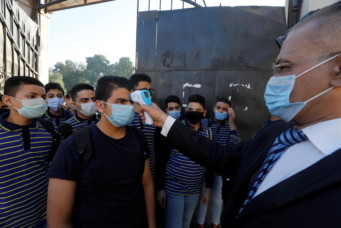Covid-19’s Not Through With Us Yet
As vaccines offer hope for a world after Covid, experts warn that in many ways, the fight is only beginning.

The global pandemic has led to more than 217 million cases of COVID-19 and roughly 4.5 million deaths.
Thanks to the widespread distribution of vaccines in some countries this spring, there was a moment when the virus seemed poised to be checked, or even largely brought under control. By mid-June, for example, the United States reached its lowest case numbers since March of 2020. Sadly this moment has passed, and is now a blip against the backdrop of a worsening global situation.
Without widespread access to vaccines, vast swaths of the globe remain unvaccinated, and the virus is spreading freely. At the time of this writing, countries that are experiencing massive spikes in new cases and deaths include India, Indonesia, Malaysia, and Vietnam, along with many regions of South America (per capita, Peru has the highest COVID-19 mortality rate in the world). Africa—which as a continent has the world’s highest death rate of patients critically ill with COVID-19 due to limited intensive care facilities and inadequate reserves of critical supplies like oxygen—is also experiencing a surge in infections.
The world is at a critical point in the pandemic, and the alarms are ringing.
Variants “Could Be Catastrophic”
“If world leaders don’t act now, the end of the Covid pandemic may come in a horrible form of herd immunity, as more transmissible variants that are taking hold around the world kill millions,” wrote sociologist Zeynep Tufekci in a May article for the New York Times. With the Delta variant now wreaking havoc among the unvaccinated worldwide, that prediction grows close to bearing out. Meanwhile, as quickly as new variants emerge, so too does misinformation about the virus, vaccines, and the politics of it all. Reliable data, and sound recommendations from governments and public health organizations simply aren’t keeping up.
Fast forward to early August, Tufekci writes “The C.D.C. is still mired in the fog of pandemic, with too little data, collected too slowly, leaving it chasing epidemic waves and trying to make sense of information from other countries. Epidemics spread exponentially, so delayed responses make problems much worse. If the response to a crisis comes after many people are already aware of it brewing, it leaves them confused and fearful if they look to the C.D.C. for guidance, and vulnerable to misinformation if they do not.”
That confusion and misinformation has left about 30 percent of eligible Americans unvaccinated, while much of the world struggles even to access vaccines. What this means is that instead of the pandemic ending by way of mass vaccinations, the odds are rising that it will end by way of enough people becoming immune via infection.
Even in countries where there is widespread vaccine availability, like the United States, if even a quarter of the population refuses to get vaccinated, that leaves tens of millions of people as a pool for the virus to infect and use as hosts to create new variants. Epidemiologists warn that if there is a large enough pool of unvaccinated people, eventually the virus could mutate into a variant that our current vaccines will not provide immunity to. Hence, the idea that with enough time countries will be able to eventually vaccinate enough people is simply not going to work.
One sign the world is heading in this direction is one of the most recent variants of concern—the Delta—which came out of the catastrophic situation in India. Due to governmental leadership in India not taking the virus seriously enough, from mid-May to late June that country experienced an utter disaster. As businesses and activities were kept open amid a surge of new cases, hospitals promptly became overwhelmed, and there were so many bodies that enough wood could not be sourced to cremate them. During this time the Delta variant arose, which worsened the situation exponentially. India has now become one of the worst countries on the planet for cases and casualties, with more than 30 million cases and over 400,000 deaths.
Britain, which has had one of the most successful responses to the virus in recent months, is now seeing an increase in cases and hospitalizations. Unlike the United States, Britain re-imposed national restrictions late last year to reduce the spread, and chose to vaccinate as many people as possible with a first round of shots (delaying second shots for many) in order to more rapidly reduce the number of cases. The virus retreated rapidly, but now cases are again increasing, and the primary cause appears to be the Delta variant. Adding to this was the UK’s decision to reopen society too quickly.
In the United States, particularly in the South where vaccination rates have lagged, the picture is darkening. The country reached a daily average of 100,000 covid hospitalizations on August 28—a threshold not seen since the height of the winter surge, when vaccines were not yet widely available. With variants, this suggests, come greater severity and transmissibility.
Tufekci points out how increased transmissibility is truly an exponential threat. “If a virus that could previously infect three people on average can now infect four, it looks like a small increase,” she wrote in a recent post on her blog. “Yet if you start with just two infected people in both scenarios, just 10 iterations later, the former will have caused about 40,000 cases while the latter will be more than 524,000, a nearly 13-fold difference.”
Whether this scenario plays out on a local, national or global level it will likely mean that most deaths in those locations will happen after the vaccines become available there, unless their distribution is rapid and widespread enough to reach herd immunity first.
Dr. Kees Kolff, an epidemiologist and public health specialist in Washington State (which was hit heavily with Covid in early 2020, but has since had one of the most effective responses in the United States) discussed the dangers of allowing the virus more time to mutate:
“The race at this point is to keep the virus from mutating too much and creating more dangerous variants,” Dr. Kolff explained. “The more people it has an opportunity to infect, the more chances one of the mutations will become more dangerous and more infectious and thus a deadlier virus. There are new variants coming out all the time, and we haven’t seen the end of it, because the majority of people in the world are not immunized.”
He, too, pointed to places like Africa, much of Asia, and most of South America as examples of this, saying that these places “are nowhere near having enough people vaccinated, and it’s a race against the mutations”. While Kolff wasn’t surprised at the rapidity with which a vaccine was produced, given how closely we have been studying coronaviruses for over a decade, he expressed grave concern about the variants.
“People who were watching coronaviruses were not surprised when this thing came out,” Dr. Kolff said. “But the danger with a pandemic is that instead of just having millions of people exposed [in whom] the virus can mutate and look for more strategies to enter humans…you now have billions of people…so the virus is having a heyday.”
Most of the mutations of the virus will “die out,” according to Kolff. “There have probably been thousands of mutations we have never even known about. Since they didn’t propagate and spread to other people, we didn’t have a chance to identify them.”
Dylan Morris, a postdoctoral researcher at the University of California, Los Angeles, studies how the evolution of RNA viruses is shaped by ecological processes within and between hosts.
In an essay titled “Novelty means Severity” penned May 18, he noted that unless the virus is eradicated, which is not likely in the short term, most people will ultimately encounter it. Those who have been vaccinated will most likely not get sick, or if they do it will be mild in comparison to the full-blown disease. Hence, Morris emphasizes, the faster vaccinations are rolled out, the more lives will be saved.
But the lack of a rapid and comprehensive worldwide rollout of vaccinations is precisely the problem.
The United States, for example, spent the taxpayer money necessary to have domestic companies develop and patent vaccines, and has rolled them out fairly quickly. Despite this, the government was unwilling at first to do all it could to share excess vaccines with the rest of the world, particularly in places where it is most needed. Thus, the disparity of vaccination availability remains glaring, resulting in needless excess deaths.
Ignoring a Life and Death Crisis
On June 5, three countries reached 60 percent or more of their total populations with their first vaccination dose. They were the UK, Israel, and Canada. As of this writing, the UAE leads the world with 87 percent of its population having received the first dose. Meanwhile, the United States is in a unique situation where it has become an example of both what to do, and what not to do.
On the one hand, largely due to the changing of administrations, the United States went from being a basket case in terms of its mishandling of the pandemic, to a country with vaccines to spare, and 52 percent of the country fully vaccinated.
Yet, the rate of people getting vaccinated has slowed to a crawl, notwithstanding some uptick in August as Delta spread and vaccine mandates began to be implemented in some places.
Epidemiologists, doctors, and public health officers around the United States have pointed out that there appears to be three main groups of people in the country. One group wants the vaccine, a second group is still questioning whether they should get vaccinated and remains undecided, and a third group will never get vaccinated, for either religious, political, or ideological reasons.
This means that, between the second two groups, there will be roughly 25-35 percent of the U.S. population (between 8,250,000 and 11,550,000 people) that will never get vaccinated. This leaves an extraordinarily large pool of people within which the virus will spread to create increasingly contagious and deadly variants.
Dr. Kolff suspects that many people don’t really understand how dangerous COVID-19 is. It is not not only a respiratory disease, he says, but also a vascular one, which has been shown to carry numerous long-term consequences in studies confirmed by the National Institute of Health and the Center for Disease Control.
There are those living with “Long Covid” with symptoms like fatigue, headache, brain fog, depression and chest pain that can last for many months. In fact, any organ of the body including the brain, heart, kidneys, and lungs can be damaged by resulting inflammation of the blood vessels, and we don’t know how long these problems will last. Dr. Kolff cited mental health issues including depression and psychosis, which scientists are only beginning to understand.
“In children it has caused something similar to Kawasaki disease, an inflammatory blood vessel disease that includes skin rashes, large lymph nodes and potentially serious heart disease if left untreated,” he notes.
The worst outbreaks in the world have taken place in India, the United States, and Brazil, in that order, all due to failed national leadership.
At the time of this writing, the United States, despite widespread vaccine availability, still has the highest number of cases and deaths (some 39,573,050 and 643,865 respectively, according to Johns Hopkins University’s Coronavirus Resource Center due largely to the negligence of the Trump Administration during the early months of the pandemic. India follows with 32,903,289 cases and 439,895 deaths, and Brazil with 20,830,495 cases and 581,914 deaths.
Tufekci has been equally critical of the situation in the United States regarding those who refuse to get vaccinated:
“Those countries which lack both widespread prior immunity from previous outbreaks (like us!) [the United States] and widespread vaccination (also like us!) are sitting ducks. Something like the Delta variant can burn through such populations like a firestorm.” she wrote in May—another forecast sadly realized.
The United States has meanwhile come under criticism for not doing enough to share its excess vaccines with countries in need where the virus is exploding.The Biden administration has begun to assist these hotspots, delivering 110 million doses abroad by early August. However, critics argue that Washington could send far more doses, and should have done so sooner, given the new variants and the deaths increasing in various places.
As the Delta variant appears poised to begin working its way through the United States in the coming weeks, it underscores the fact that as long as the virus remains uncontrolled in one part of the world, it will inevitably make its way back into other places where it was thought to be on the way out.
“In fact, after this coronavirus or a relative thereof has forced enough people to become relatively immune by death, disease or vaccination, it will likely become endemic in much of the world,” Dr. Kolff concluded. “It’s not through with us yet and we will surely need additional vaccines and public health measures in the future. Measures that we know can save lives.”
At the time of this writing, the World Health Organization has reported 4.4 million new cases and 2.6 million new cases and just over 67,000 new deaths for the last week of August. These numbers track with the week prior, and overall show a steady increase throughout the past two months..
The virus has now led to millions of deaths and counting, with untold further damage to livelihoods and economies. Given that it is poised to become endemic in most countries—due largely to either abject failure of government leadership or lack of vaccine availability—these numbers are guaranteed to grow, and substantially at that.




